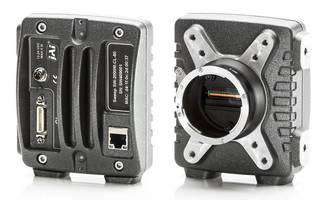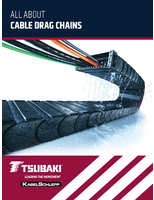Monochrome Line Scan Cameras offer large pixels, high scan rates.
Press Release Summary:

Respectively delivering scans rates up to 80,000 and 65,000 lines/sec, Sweep models SW-2000M-CL-80 and SW-2000M-CL-65 feature 2,048 pixel resolution and 20 x 20 µm pixels. Quantum well capacity and 400 µm² photon collection area promote SNR, while pixel size helps lower Modulation Transfer Function (MTF) requirements of camera lens. Other features include Ethernet port, scalable resolution function, single-channel Camera Link interface, and dual mode-capable image sensor.
Original Press Release:
JAI Introduces New Sweep Series of Monochrome Line Scan Cameras Combining Large Pixels and High Scan Rates
COPENHAGEN, DENMARK – Today, JAI launched a completely new series of industrial monochrome line scan cameras under the family name Sweep. The new cameras combine high scan rates with extra-large high sensitivity pixels requiring less scene light than conventional line scan cameras to produce quality images. The first two models in the new Sweep Series (SW-2000M-CL-80 and SW-2000M-CL-65) both feature 2048 pixel resolution, 20 µm x 20 µm large pixels, and deliver scans rates up to 80,000 lines/second (80 kHz model) and 65,000 lines/second, respectively.
The Sweep SW-2000M is the only line scan camera currently on the market offering 20 µm x 20 µm large pixels. This provides a range of advantages to vision system designers.
With a 400 µm² photon collection area and a large quantum well capacity, these new line scan cameras provide an excellent signal/noise ratio, maximizing the image quality even in line scan applications where providing enough scene light is difficult due to the physical constraints or limitations in light budget.
The high sensitivity pixels make the Sweep SW-2000M capable of capturing an acceptable exposure at 4 times the speed of a camera with only 10-micron pixels, providing system integrators an opportunity to scale down their investment in expensive lighting solutions.
Large pixels provide further advantages by lowering the “Modulation Transfer Function (MTF)” requirements of the camera lens, which means that Sweep SW-2000M has a higher tolerance to “lens blur” making it less dependent on high quality lenses to obtain the required image quality.
The cameras are equipped with an Ethernet port for remote control, firmware updates and download of user software and documents. It also has a “scalable resolution function” making it possible to set the camera to any resolution below 2048 pixels.
The image sensor can be set in two operating modes – a higher dynamic range mode and a responsive mode. In the higher dynamic range mode the quantum well can contain as many as 360k electrons delivering images with high signal/noise levels. In vision inspection situations where the scene light is limited the camera can be switched to “responsive mode” (collecting 60k electrons). In the responsive mode the sensor’s quantum well fills up faster, providing a higher response on the grey scale. The resulting images have greater brightness and better contrast.
The first models in the Sweep Series are equipped with a single-channel Camera Link interface (Base Configuration) and can output 8/10/12 bits per pixel in single, dual, or triple data formats.
About JAI
JAI is a manufacturer of high quality, industrial-grade cameras for the machine vision, transportation, aerospace, homeland security, medical and scientific markets.
JAI’s broad product line features high performance progressive scan CCD cameras with spatial resolutions from VGA to 20 megapixels; traditional interlaced video cameras; intensified cameras with sensitivity to light levels as low as .00001 lux, and a range of innovative multi-imager prism-block cameras including both area scan and line scan models.Â
Physical interfaces include the Camera Link®, GigE Vision®, CoaXPress, and USB3 Vision high performance digital standards, as well as both TV-standard and analog progressive scan output.
JAI cameras help improve customer businesses in a variety of ways, whether by improving quality and accuracy, lowering costs, increasing yields, or simply enabling better service. In addition to cameras, JAI’s traffic solutions group is one of the world’s leading manufacturers of specialized traffic systems. Solutions are based on JAI-developed hardware and software, which is often integrated with third-party products.




